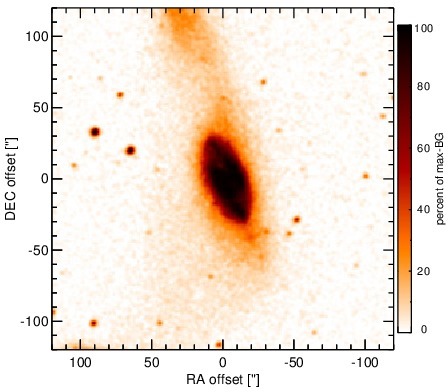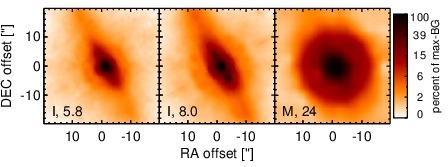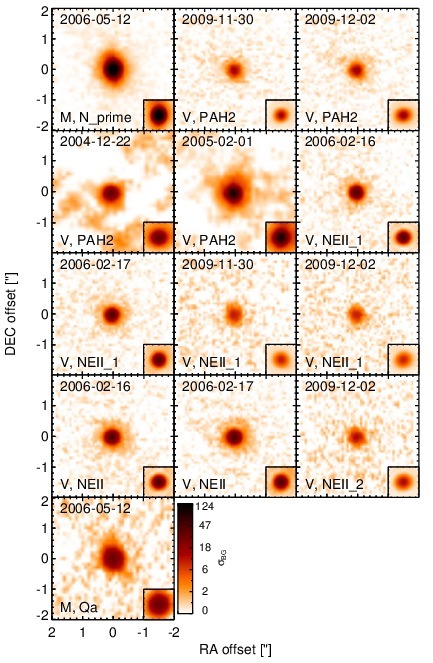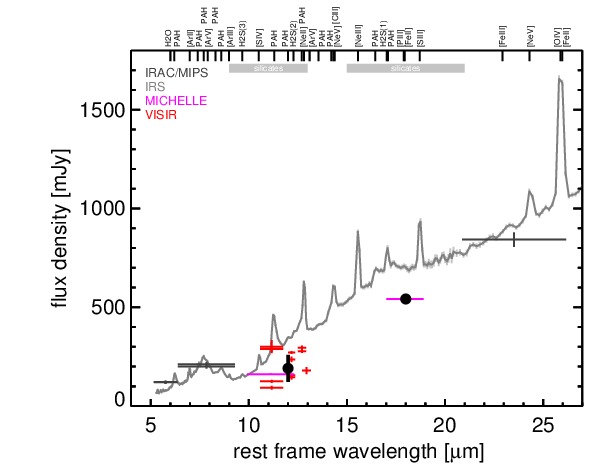Sasmirala Individual Information for NGC 2992
Description
NGC 2992 is a highly-inclined spiral galaxy interacting with NGC 2993 2.9arcmimin to the south at a redshift of z = 0.0077 (D ~ 39.7 Mpc) with a well-studied AGN belonging to the nine-month BAT AGN sample. This AGN exhibits huge X-ray variations (factor of ~ 20; e.g., [murphy_monitoring_2007]) and has changed its optical type between Sy 1.5 and Sy 2.0, which is presumably caused by intrinsic changes in the ionizing continuum rather than varying obscuration [gilli_variability_2000, trippe_long-term_2008]. The nucleus is obscured by a crossing prominent dust lane instead [ward_new_1980]. The AGN is surrounded by an extended biconical NLR with a total extent of ~ 5 kpc (PA~ 125∘;e.g., [allen_physical_1999]). At radio wavelengths, a compact radio core and a prominent double loop structure extending in total 8arcsec (~ 1.5 kpc) to the north-west and south-east (PA~ 154∘; [ulvestad_radio_1984, wehrle_radio_1988]), which are possibly generated by an AGN-driven jet [colbert_large-scale_1998, veilleux_biconical_2001]. The first MIR observations were performed by [glass_mid-infrared_1982], [lonsdale_infrared_1984], followed by [aitken_8-13_1985], [ward_continuum_1987], and [roche_atlas_1991]. Subarcsecond N-band imaging was then performed with Palomar 5 m/MIRLIN [gorjian_10_2004], with Keck/LWS [soifer_high_2004], and with ESO 3.6 m/TIMMI2 [galliano_mid-infrared_2005]. In all cases an unresolved MIR nucleus without extended host emission was detected. In the Spitzer/IRAC images lenticular extended host emission was detected in addiction to the MIR nucleus, while NGC 2992 appears compact in the MIPS images. We extract the nuclear component resulting in an IRAC 5.8 flux consistent with [gallimore_infrared_2010], while the 8.0 μm value is significantly lower. The IRS LR staring-mode spectrum exhibits silicate 10 μm absorption, prominent PAH features and forbidden emission lines, and a generally red spectral slope in νFν-space (see also [wu_spitzer/irs_2009, deo_mid-infrared_2009, gallimore_infrared_2010]). Thus, it appears that NGC 2992 is significantly affected by star formation on arcsecond scales, although on nuclear scales [friedrich_adaptive_2010] constrain star formation to be minor. NGC 2992 was repeatedly observed with VISIR in four narrow N-band filters spread over 2004, 2005, 2006 and 2009. The first two measurements were published in [haas_visir_2007]. In addition, Michelle imaging in the N’ and Qa filters was performed in 2006 [ramos_almeida_infrared_2009]. A compact MIR nucleus was detected in all cases, while the deepest image (N’) shows very faint edge-on spiral-like emission extending from the nucleus similar to the IRAC 8 μm image (PA~ 30∘; diameter~ 13arcsec ~ 2.5 kpc). The nucleus itself is extended in the north-south directions in that image as well (PA~ 5∘; FWHM(major axis)~ 0.49arcsec ~ 90 pc). It appears resolved also in the sharpest image (NEII_1 from 2006-02-16) but with a slightly larger position angle (PA~ 12∘). Thus, we classify the nucleus of NGC 2992 as resolved in the MIR at subarcsecond resolution. On average, the nuclear PSF photometry is ~ 42% lower than the Spitzer spectrophotometry. However, we notice that the VISIR measurements from 2009 are systematically ~ 48% lower than the VISIR measurements from 2006 in the same filters. The Michelle and early VISIR total fluxes are rather consistent with the Spitzer data, and possibly also with the historical measurements. Such a comparison is however complicated by the strong MIR features in the N-band at arcsecond scales. Thus, it is possible that NGC 2992 exhibits long-term MIR flux variations similar to shorter wavelengths (e.g., [glass_variability_1997]). For these reasons, we are also unable to constrain the spectral features as silicate and PAH at subarcsecond resolution, despite the good N-band coverage.
- [aitken_8-13_1985] D. K. Aitken and P. F. Roche. 8-13 microns spectrophotometry of galaxies. IV - six more seyferts and 3C345. v - the nuclei of five spiral galaxies . MNRAS , 213 pp. 777–797, April 1985.
- [allen_physical_1999] Mark G. Allen, Michael A. Dopita, Zlatan I. Tsvetanov, and Ralph S. Sutherland. Physical conditions in the seyfert galaxy NGC 2992 . ApJ , 511 pp. 686–708, February 1999.
- [colbert_large-scale_1998] Edward J. M. Colbert, Stefi A. Baum, Christopher P. O'Dea, and Sylvain Veilleux. Large-scale outflows in edge-on seyfert galaxies. III. kiloparsec-scale soft x-ray emission . ApJ , 496 pp. 786, March 1998.
- [deo_mid-infrared_2009] Rajesh P. Deo, Gordon T. Richards, D. M. Crenshaw, and S. B. Kraemer. The mid-infrared continua of seyfert galaxies . ApJ , 705 pp. 14–31, November 2009.
- [friedrich_adaptive_2010] S. Friedrich, R. I. Davies, E. K. S. Hicks, H. Engel, F. Müller-Sánchez, R. Genzel, and L. J. Tacconi. Adaptive optics near infrared integral field spectroscopy of NGC 2992 . A&A , 519 pp. 79, September 2010.
- [galliano_mid-infrared_2005] E. Galliano, D. Alloin, E. Pantin, P. O. Lagage, and O. Marco. Mid-infrared imaging of active galaxies. active nuclei and embedded star clusters . A&A , 438 pp. 803–820, August 2005.
- [gallimore_infrared_2010] J. F. Gallimore, A. Yzaguirre, J. Jakoboski, M. J. Stevenosky, D. J. Axon, S. A. Baum, C. L. Buchanan, M. Elitzur, M. Elvis, C. P. O'Dea, and A. Robinson. Infrared spectral energy distributions of seyfert galaxies: Spitzer space telescope observations of the 12 μm sample of active galaxies . ApJS , 187 pp. 172–211, March 2010.
- [gilli_variability_2000] R. Gilli, R. Maiolino, A. Marconi, G. Risaliti, M. Dadina, K. A. Weaver, and E. J. M. Colbert. The variability of the seyfert galaxy NGC 2992: the case for a revived AGN . A&A , 355 pp. 485–498, March 2000.
- [glass_mid-infrared_1982] I. S. Glass, A. F. M. Moorwood, and W. Eichendorf. Mid-infrared observations of seyfert 1 and narrow-line x-ray galaxies . A&A , 107 pp. 276–282, March 1982.
- [glass_variability_1997] I. S. Glass. Variability of seyfert galaxies in the near-infrared. i - an outburst in NGC 2992 . MNRAS , 292 pp. L50–L54, December 1997.
- [gorjian_10_2004] V. Gorjian, M. W. Werner, T. H. Jarrett, D. M. Cole, and M. E. Ressler. 10 micron imaging of seyfert galaxies from the 12 micron sample . ApJ , 605 pp. 156–167, April 2004.
- [haas_visir_2007] M. Haas, R. Siebenmorgen, E. Pantin, H. Horst, A. Smette, H.-U. Käufl, P.-O. Lagage, and R. Chini. VISIR / VLT mid-infrared imaging of seyfert nuclei: nuclear dust emission and the seyfert-2 dichotomy . A&A , 473 pp. 369–376, October 2007.
- [lonsdale_infrared_1984] C. J. Lonsdale, S. E. Persson, and K. Matthews. Infrared observations of interacting/merging galaxies . ApJ , 287 pp. 95–107, December 1984.
- [murphy_monitoring_2007] Kendrah D. Murphy, Tahir Yaqoob, and Yuichi Terashima. Monitoring the violent activity from the inner accretion disk of the seyfert 1.9 galaxy NGC 2992 with RXTE . ApJ , 666 pp. 96–108, September 2007.
- [ramos_almeida_infrared_2009] C. Ramos Almeida, N. A. Levenson, J. M. Rodríguez Espinosa, A. Alonso-Herrero, A. Asensio Ramos, J. T. Radomski, C. Packham, R. S. Fisher, and C. M. Telesco. The infrared nuclear emission of seyfert galaxies on parsec scales: Testing the clumpy torus models . ApJ , 702 pp. 1127–1149, September 2009.
- [roche_atlas_1991] Patrick F. Roche, David K. Aitken, Craig H. Smith, and Martin J. Ward. An atlas of mid-infrared spectra of galaxy nuclei . MNRAS , 248 pp. 606–629, February 1991.
- [soifer_high_2004] B. T. Soifer, G. Neugebauer, K. Matthews, E. Egami, and L. Armus. High spatial resolution mid-infrared observations of five seyfert galaxies . PASP , 116 pp. 493–496, June 2004.
- [trippe_long-term_2008] M. L. Trippe, D. M. Crenshaw, R. Deo, and M. Dietrich. Long-term variability in the optical spectrum of the seyfert galaxy NGC 2992 . AJ , 135 pp. 2048–2054, June 2008.
- [ulvestad_radio_1984] J. S. Ulvestad and A. S. Wilson. Radio structures of seyfert galaxies. VI - VLA observations of a nearby sample . ApJ , 285 pp. 439–452, October 1984.
- [veilleux_biconical_2001] S. Veilleux, P. L. Shopbell, and S. T. Miller. The biconical outflow in the seyfert galaxy NGC 2992 . AJ , 121 pp. 198–209, January 2001.
- [ward_continuum_1987] Martin Ward, Martin Elvis, G. Fabbiano, N. P. Carleton, S. P. Willner, and A. Lawrence. The continuum of type 1 seyfert galaxies. i - a single form modified by the effects of dust . ApJ , 315 pp. 74–91, April 1987.
- [ward_new_1980] M. Ward, M. V. Penston, J. C. Blades, and A. J. Turtle. New optical and radio observations of the x-ray galaxies NGC 7582 and NGC 2992 . MNRAS , 193 pp. 563–582, November 1980.
- [wehrle_radio_1988] Ann E. Wehrle and Mark Morris. Radio and h-alpha images of the 'figure-8' radio nucleus of the interacting seyfert galaxy NGC 2992 . AJ , 95 pp. 1689–1694, June 1988.
- [wu_spitzer/irs_2009] Yanling Wu, Vassilis Charmandaris, Jiasheng Huang, Luigi Spinoglio, and Silvia Tommasin. Spitzer/IRS 5-35 μm low-resolution spectroscopy of the 12 μm seyfert sample . ApJ , 701 pp. 658–676, August 2009.
Images

Optical image (DSS, red filter). Displayed are the central 4 arcmin with North being up and East to the left. The colour scaling is linear with white corresponding to the median background (BG) and black to the 0.01% pixels with the highest intensity.

Spitzer MIR images. Displayed are the inner 40 arcsec with North being up and East to the left. The colour scaling is logarithmic with white corresponding to median BG and black to the 0.1% pixels with the highest intensity. The label in the bottom left states instrument and central wavelength of the filter in micron (I: IRAC, M: MIPS).

Subarcsecond-resolution MIR images sorted by increasing filter central wavelength. Displayed are the inner 4 arcsec with North being up and East to the left. The colour scaling is logarithmic with white corresponding to median BG and black to the 75% of the highest intensity of all images in units of sig_bg. The inset image (where present; either bottom or top right) shows the central arcsecond of the PSF from the calibrator star, scaled to match the science target. The labels in the bottom left state instrument and filter names (C: COMICS, M: Michelle, T: T-ReCS, V: VISIR).
SEDs


MIR SED. The description of the symbols in all the SED plots (where present) is the following: Grey crosses and solid lines mark the Spitzer/IRAC, MIPS and IRS data. The colour coding of the other symbols is as follows: green for COMICS, magenta for Michelle, blue for T-ReCS and red for VISIR data. Darker-coloured solid lines mark spectra of the corresponding instrument. The black filled circles mark the nuclear 12 and 18 micron continuum emission estimate from the data (where present). The ticks on the top axis mark positions of common MIR emission lines, while the light grey horizontal bars mark wavelength ranges affected by the silicate 10 and 18 micron features.